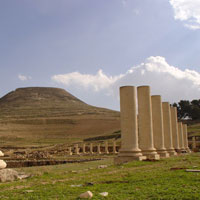 As soon as you reach the outskirts of Bethlehem, you can’t help but notice the flat topped mountain in the distance. This is Herodium, built by Herod the Great in 42 B.C. Located in the Jerusalem Wilderness‚ Herodium lies 6 kilometres to the southeast of Bethlehem. While the Crusaders (Franks) named it the “Mountain of the Franks,” to the local inhabitants it is known as Jabel El-Fourdis, or Paradise Mountain. According to the Roman historian Josephus, there were twin-rounded hills in the site. Herod cut one of the two hills down and piled the rock and earth on the other. On the great mound thus produced, he constructed a circular palace, adorned with towers, and reached by a marble staircase, the traces of which still exist. Down below, Herodium laid a great cistern and an aqueduct which brought water from Solomon’s Pools. Remains of a double circular curtain wall with four towers and a gateway from the north-east, a hall with pillars and a bathhouse, the remains of three Byzantine chapels with rich decorative mosaic floors were discovered. Below Herodium, the area at the foot of the mountain to the north includes the remains of a fortress, storerooms, a hippodrome and a pool. Used by Jewish rebels, the fortress was destroyed by the Romans after the fall of Jerusalem in 70 A.D. Although located in the Bethlehem District, Herodium is run by the Israeli National Parks Authority.
As soon as you reach the outskirts of Bethlehem, you can’t help but notice the flat topped mountain in the distance. This is Herodium, built by Herod the Great in 42 B.C. Located in the Jerusalem Wilderness‚ Herodium lies 6 kilometres to the southeast of Bethlehem. While the Crusaders (Franks) named it the “Mountain of the Franks,” to the local inhabitants it is known as Jabel El-Fourdis, or Paradise Mountain. According to the Roman historian Josephus, there were twin-rounded hills in the site. Herod cut one of the two hills down and piled the rock and earth on the other. On the great mound thus produced, he constructed a circular palace, adorned with towers, and reached by a marble staircase, the traces of which still exist. Down below, Herodium laid a great cistern and an aqueduct which brought water from Solomon’s Pools. Remains of a double circular curtain wall with four towers and a gateway from the north-east, a hall with pillars and a bathhouse, the remains of three Byzantine chapels with rich decorative mosaic floors were discovered. Below Herodium, the area at the foot of the mountain to the north includes the remains of a fortress, storerooms, a hippodrome and a pool. Used by Jewish rebels, the fortress was destroyed by the Romans after the fall of Jerusalem in 70 A.D. Although located in the Bethlehem District, Herodium is run by the Israeli National Parks Authority.



 O-Sense
O-Sense
